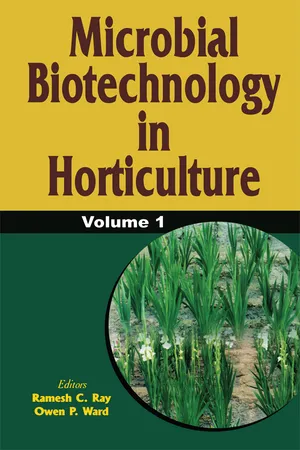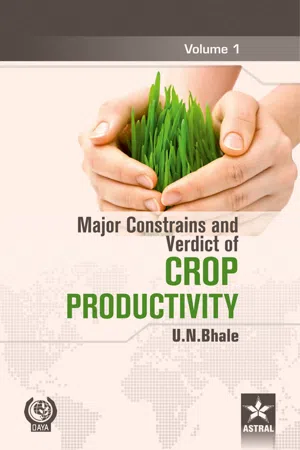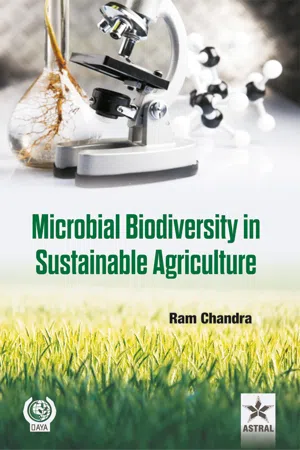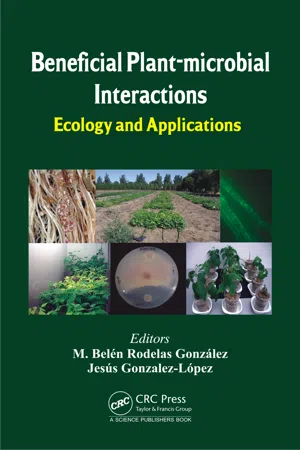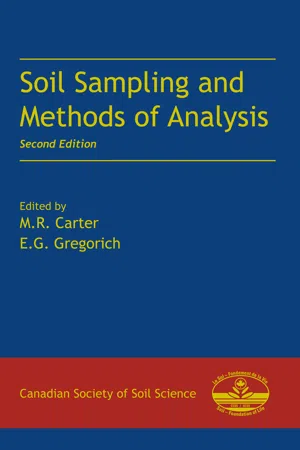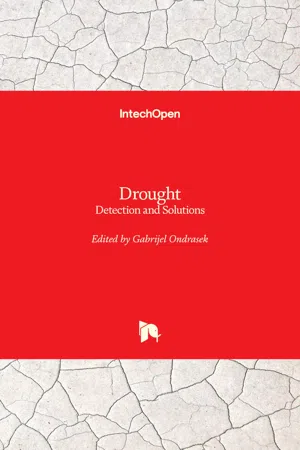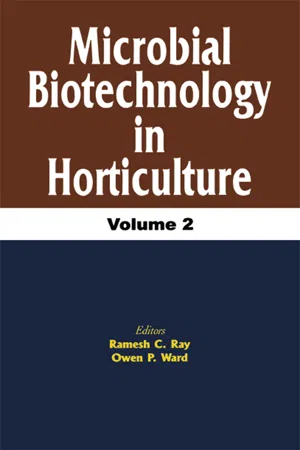Biological Sciences
Arbuscular Mycorrhizal Fungi
Arbuscular mycorrhizal fungi are a type of symbiotic fungi that form mutualistic relationships with the roots of most plant species. They facilitate the exchange of nutrients between plants and soil, particularly phosphorus and nitrogen, enhancing the plants' ability to absorb these essential elements. These fungi are characterized by their arbuscules, which are tree-like structures within the plant roots where nutrient exchange occurs.
Written by Perlego with AI-assistance
Related key terms
1 of 5
12 Key excerpts on "Arbuscular Mycorrhizal Fungi"
- R C Ray(Author)
- 2006(Publication Date)
- CRC Press(Publisher)
INTRODUCTION A rbuscular mycorrhizal (AM) fungi are the predominant fungi involved in fungal root symbiosis, abundant in soils of all continents (Harley, 1991). Evidence from fossil records (Stubblefield et al., 1987), morphological studies (Morton, 1990) and r DNA nucleotide sequence analysis (Simon et al., 1992) suggest that these associations co-evolved with plants. These fungi have been reported from almost all environments including aquatic (Bagyaraj et al., 1979) to xerophytic (Williams and Aldon, 1976), from lowland tropical rainforests (Janos, 1987) to high altitudes (Allen et al., 1987) and even in the canopy of epiphytes (Nadkami, 1985). Research on the ecology of these fungi has been carried out for several decades and at present over 130 species of these fungi have been identified and classified in the order Glomales belonging to the class Zygomycetes (Morton and Benny, 1990). Though these fungi occur in such diverse habitats, they benefit the host plants in several ways (Sylvia and Williams, 1992; Bagyaraj and Varma, 1994). Their role is in improving the nutritional status of hosts, particularly with respect to phosphorus Corresponding Author Utilization of Arbuscular Mycorrhizal Fungi! in Horticulture Bagyaraj*, Chiramel Tharun 2 2 2 MICROBIAL TECHNOLOGY IN HORTICULTURE— VOL. 1 (P) nutrition, conferring resistance to soil-borne diseases, alleviating the effects of salt and water stress (Nelson and Safir, 1982; Sharma et al., 1992; Jarstfer and Sylvia, 1992; Auge, 2001) and improving the yield of several agricultural and horticultural crops. This has led to the initiation and advancement of research aimed at conserving these fungal associations and also directed to their inclusion as an essential component in sustainable crop production systems.- eBook - PDF
- Ramasamy K. And K.Kumar(Author)
- 2020(Publication Date)
- NEW INDIA PUBLISHING AGENCY (NIPA)(Publisher)
C HAPTER - 19 Arbuscular Mycorrhizal Symbiosis from Basics to Application: Potential & Prospects in Soil-Plant Production Systems Shivani Garg 1 , Mahaveer Sharma 1 and K. Annapurna 2 * 1 Directorate of Soybean Research, Khandwa Road, Indore – 452 001 2 Division of Microbiology, Indian Agricultural Research Institute, New Delhi – 110 012 *Corresponding author. E-mail: [email protected] Abstract Agricultural production is often limited by low phosphorus (P) availability. In developing countries, which have limited access to P fertiliser, there is a need to develop plants that are more efficient at low soil P. Arbuscular mycorrhizal (AM) symbioses are widespread in the plant kingdom and contribute significantly to plant P nutrition and growth in natural ecosystems. Production and application of these beneficial fungi for agricultural purposes has grown over the last decades worldwide. However, the necessity of AM inoculum production via a host plant is still an obstacle to ample utilization of AM fungi in agricultural crops. The present article deals with the basic and applied aspects of AM research and its role in sustainable agriculture. Introduction Arbuscular Mycorrhizal Fungi (AMF) are known to forage efficiently for soil nutrients especially P and forward them to plants associated symbiotically with them. The constant increase in food demand throughout the world, the rise of biofuels production and the imminent depletion of phosphate stock provisioning strengthen the necessity to support research on mycorrhizal symbioses. Mycorrhiza is a symbiotic interaction between two eukaryotes, an obligate biotrophic fungus and a plant where both partners benefit from the reciprocal nutrient exchange. Roots of over 80% of all terrestrial plant species (including agricultural and horticultural 347 348 Plant-Microbe Interactions crops) associate symbiotically with fungi. This interaction was instrumental in successful colonization of land by plants [1]. - Bhale, U N(Authors)
- 2021(Publication Date)
- Daya Publishing House(Publisher)
Chapter 36 Arbuscular Mycorrhizal Fungi: An Environo-friendly Bioinoculant for Sustainable Agriculture D.D. Namdas* P.G. Research Laboratory, Department of Botany, Dahiwadi College, Dahiwadi – 415 508 Tal. Man, Dist. Satara, Maharashtra, India Introduction The term mycorrhizae refer to a plant root associated with symbiotic fungus, which is functionally distinct organ involved in mineral nutrient uptake from soil. Microbial communities of soil include bacteria actinomycetes, fungi, algae, protozoans and others which play important role in cycling of elements, biological conversions, humas formation, ecosystem sustains, geo-chemical cycling and productivity. Among the microbial communities, the most important and widespread symbiotic microorganisms are the vesicular arbuscular mycorrhizal (VAM) fungi. Occurrence of VAM fungi is ubiquitous. Distribution of VAM is markedly influenced by climatic and edaphic factors and also land use. These includes soil fertility, soil moisture, pH, temperature, altitude, soil organic matter, plant susceptibility, light intensity and depth in addition to disturbance (Mohankumar and Sivaswamy, 1992). Research efforts during past few years throughout the world made their attention towards commercial exploitation of microbes for sustainable agriculture. Mycorrhizae forms mutualistic symbiotic association between the fine roots of most plant species and fungi. Plant provides nutrients to the This ebook is exclusively for this university only. Cannot be resold/distributed. fungus and in return fungus provides inorganic nutrients to the plant through hyphal colonization in cortical tissue of the root during the growth. Mycorrhizae plays significant role in phosphate solubilization, mobilization and nutrient uptake in growth and development of plants hence, called ‘Phosphorous gathering fungi’.- Tanya E. Cheeke, David C. Coleman, Diana H. Wall(Authors)
- 2012(Publication Date)
- CRC Press(Publisher)
133 chapter 7 The contribution of Arbuscular Mycorrhizal Fungi to the success or failure of agricultural practices David D. Douds Jr. USDA-ARS Eastern Regional Research Center Rita Seidel The Rodale Institute 7.1 Introduction to the biology of Arbuscular Mycorrhizal Fungi Arbuscular mycorrhizal (AM) fungi are soilborne fungi that generally form a mutualistic symbiosis with the majority of crop plants. However, one agronomically important crop family that does not form arbuscular mycorrhizas is the Brassicaceae. Among the benefits to the plant host ascribed to the symbiosis are enhanced mineral nutrient uptake, water relations, and disease resistance. The fungus benefits from the receipt of fixed carbon through the roots of the host plant (Shachar-Hill et al., 1995). A brief discussion of the life cycle and function of AM fungi will help understand and predict both the impacts of farm management practices on AM fungi and the role of AM fungi in the success or failure of certain agronomic practices. Contents 7.1 Introduction to the biology of Arbuscular Mycorrhizal Fungi ..................................... 133 7.1.1 Life cycle of AM fungi .......................................................................................... 134 7.1.2 Functioning of the symbiosis ............................................................................... 134 7.2 Interaction of agricultural practices with communities of AM fungi ....................... 135 7.2.1 Reduced tillage ....................................................................................................... 136 7.2.1.1 Agronomic background ......................................................................... 136 7.2.1.2 Role of AM fungi ..................................................................................... 138 7.2.2 Crop rotation ..........................................................................................................- Chandra, Ram(Authors)
- 2021(Publication Date)
- Daya Publishing House(Publisher)
Chapter 2 Arbuscular Mycorrhiza: A Versatile Component in Agro-Ecological Matrix Sumita Pal 1 * , Amitava Rakshit 2 and H.B. Singh 2 1 Department of Mycology and Plant Pathology 2 Department of Soil Science and Agricultural Chemistry, Institute of Agricultural Sciences, BHU, Varanasi – 221 005, India ABSTRACT Soil microbial populations are immersed in a framework of interactions known to affect plant fitness and soil quality. Beneficial microbial interactions involving arbuscular mycorrhiza, the omnipresent fungus-plant beneficial symbiosis is our main focus. They are involved in fundamental activities that ensure the stability and productivity of both agricultural systems and natural ecosystems. Both form of research has demonstrated that certain co-operative microbial activities can be exploited, as a low-input biotechnology, to help sustainable, environmentally-friendly, agro-technological practices. An analysis of the co-operative arbuscular mycorrhizal activities known to affect plant development is the general aim of this review . Keywords : Arbuscular mycorrhiza, Rhizosphere, Sustainability . Introduction “Plants don’t have roots, they have mycorrhizas (J.L. Harley)”. This strong statement was made to make it very clear that mycorrhizae are the rule in nature, not the exception and the fact that under natural conditions more than 90 per cent of all known species are associated with soil fungi in a mutualistic symbiosis, termed mycorrhizas. Mycorrhizal fungi are symbionts in roots of majority of higher plants. The word mycorrhizae was first used by German researcher A.B. Frank in 1885, and originates from the Greek mycos , This ebook is exclusively for this university only. Cannot be resold/distributed. meaning ‘fungus’ and rhiza , meaning ‘root’. Mycorrhiza is a symbiotic mutualistic relationship between special soil fungi and fine plant roots; it is neither the fungus nor the root, but rather the structure formed from these two partners.- eBook - PDF
- Chantal Hamel(Author)
- 2007(Publication Date)
- CRC Press(Publisher)
Chapter 4 Capturing the Benefits of Arbuscular Mycorrhizae in Horticulture John Larsen Sabine Ravnskov Jorn Nygaard Sorensen Over the past decade, inocula of Arbuscular Mycorrhizal Fungi (AMF) have become commercially available, but we are still far from integrating arbuscular mycorrhiza (AM) into plant production. The role of AMF in plant production has been marginalized in high-input agriculture through the use of pesticides and fertilizers, creating sce narios where the symbiosis may even be causing growth depressions when the cost (carbon drain) of the symbiosis becomes higher than the benefit (phosphorous uptake) (Ryan and Graham, 2002). More recently, the focus has been on areas with little or no AMF inoculum potential, such as plant production in horticulture that is based on soilless growth media. AMF have also been used in the restoration of disturbed landscapes, such as after major construction work (Dodd et al., 2002), in the bioremediation of polluted soils (Joner and Ley- val, 2003; Vivas et al., 2003), and in the restoration of desertified eco systems (Requena et al., 2001). Since several other reviews on AM and horticulture are available (Linderman, 1986; Gianinazzi, Trouvelot, and Gianinazzi-Pearson, 1990; Azcon-Aguilar and Barea, 1997; Vosatka et al., 1999; Marx, Marrs, and Cordell, 2002), this chapter is not an extensive review on Mycorrhizae in Crop Production © 2007 by The Haworth Press, Inc. All rights reserved. doi:10.1300/5425_04 123 124 MYCORRHIZAE IN CROP PRODUCTION AMF and horticulture; rather, it is an update presenting the prospects and limitations for integrating AMF into horticultural plant produc tion, with a focus on compatibility between AMF and plant pro duction systems. ROLE OF AM IN PLANT PRODUCTION In the early phase of AM research (1960s-1980s), researchers fo cused on plant nutrition and tried to promote the commercial use of AMF as biofertilizers for plant production. - eBook - PDF
Beneficial Plant-microbial Interactions
Ecology and Applications
- M. Belén Rodelas González, Jesús Gonzalez-López, M. Belén Rodelas González, Jesús Gonzalez-Lopez, M. Belén Rodelas González, Jesús Gonzalez-Lopez(Authors)
- 2016(Publication Date)
- CRC Press(Publisher)
Diverse chemical, physical and biological factors are involved in the framework of plant-soil interactions responsible for a sustainable ecosystem functioning (Barea et al. 2005a). The biological components are based on diverse genetic and functional groups of soil microbial populations able to carry out critical ecosystem functions such as the biogeochemical cycling of mineral nutrients, organic matter decomposition and the formation and maintenance of soil structure, key issues in a sustainable production scenario (Barea et al. 2005b, Chaudhary et al. 2009, Richardson et al. 2009). Among the beneficial microbes, mycorrhizal fungi are recognized as one of the most influential group of soil biota in the context of ecosystem sustainability once they establish mutualistic plant-fungus symbioses, so-called mycorrhizas (Jeffries and Barea 2012). Mycorrhizal associations are formed by most vascular plant species on Earth and can be found in almost all terrestrial ecosystems worldwide (Smith and Read 2008, Brundrett 2009), being universally accepted that they are fundamental to improve plant performance and soil quality (Jeffries et al. 2003). Mycorrhizal functioning is based on the exchange of nutrients and energy between both the plant and fungal partners (Brundrett 2002). A variety of mycorrhizal types are formed, depending on the plant and fungal taxa involved. However, arbuscular mycorrhizal (AM) symbiosis is the most common and over 70 percent of plant species are capable of forming these associations (Smith and Read 2008, Brundrett 2009). This chapter will focus on AM symbiosis but the importance and ecological meaning of other mycorrhizal types are reviewed in this book (Chapter 17). AM fungi, included in the phylum Glomeromycota (Schüßler et al. 2001), are ubiquitous soil-borne fungi, whose origin and divergence have been dated back over 450 million years (Redecker et al. 2000, Honrubia 2009, Schübler and Walker 2011). - eBook - PDF
- M.R. Carter, E.G. Gregorich, M.R. Carter, E.G. Gregorich(Authors)
- 2007(Publication Date)
- CRC Press(Publisher)
Chapter 30 Arbuscular Mycorrhizae Y. Dalpe ´ Agriculture and Agri-Food Canada Ottawa, Ontario, Canada C. Hamel Agriculture and Agri-Food Canada Swift Current, Saskatchewan, Canada 30.1 INTRODUCTION Most plant species live in a symbiotic association with mycorrhizal fungi whose establish-ment in roots increases the water supply and mineral nutrition. These soil-borne fungi colonize the root cortex and develop external filaments, making connecting bridges between roots and soil. They are recognized as improving plant fitness and soil quality. Widely distributed under all ecosystems, they are the most common type of symbionts involved in agricultural systems, influencing both plant production and plant protection. The mycorrhizal fungi can be subdivided into three major categories: (1) the arbuscular mycorrhizal (AM) fungi, obligate symbionts, which belong to the Glomeromycota associated with the majority of herbaceous and cultivated plants and with some deciduous trees, (2) the ectomycorrhizal (EM) fungi taxonomically associated with Basidiomycetes and Ascomy-cetes found in symbiosis mostly with trees, and (3) the ericoid mycorrhizal (ERM) fungi, a symbiosis between mainly Ascomycetes and plants from the Ericaceae family (e.g., blue-berry, rhododendron, and heather-type plants). 30.2 SAMPLING STRATEGY Several procedures used in mycorrhizal research are time consuming. Thus, sampling plans will often have to be a compromise between a desire for precision and limited resources. More intensive or targeted sampling protocols are required in heterogeneous sites to allow for the accurate measurement of variables. Therefore, knowledge of the conditions causing variation in the distribution of AM structures in soil may help develop efficient sampling plans. Sampling strategies must be planned carefully according to the experimental goal, the conditions of the study area, and knowledge on how these conditions may influence AM fungi distribution in soil. - eBook - PDF
- Gupta, Rajan Kumar(Authors)
- 2021(Publication Date)
- Daya Publishing House(Publisher)
Arbuscular Mycorrhizal Fungi: more diverse than meets the eye, and the ecological tale of why. Bioscience , 2001; 51 : 923–931. 81. Van der Heijden. Arbuscular Mycorrhizal Fungi as determinant of plant diversity, in search for underlying mechanisms and general principles. In: van der Heijden MGA, Sanders IR. Editors. Mycorrhizal Ecology. This ebook is exclusively for this university only. Cannot be resold/distributed. Ecological studies. 157. Springer Verlag, 2002. pp. 243–265. 82. Munkvold L, Kjoller R, Vestberg M, Rosendahl S, Jakobsen I. High functional diversity with in species of arbuscular–mycorrhizal fungi, New Phytol 2004; 164 : 357–364. 83. Rozema J, Arp W, Vandiggelen J, Vanesbroek M, Broekman R, Punte H. Occurrence and ecological significance of vesicular arbuscular mycorrhizae in the salt Marsh environment. Acta Botanica Neerlandica 1986; 35 : 457–467. 84. Dwivedi OP. Studies in soil micro-organisms with special reference to vesicular– arbuscular mycorrhizal (VAM) fungal association with wheat crop of Sagar region. Ph.D. Thesis. Dr. H.S. Gour University, Sagar (MP)., 2003. 85. Soni A. Studies on diversity of AMF with special reference to legume crops of Sagar region. Ph.D. Thesis. Dr. H.S.G. University, Sagar, Madhya Pradesh, India., 2006. 86. Ojala JC, Linderman RG. Preinoculation of lettuce and onion with VA mycorrhizal fungi reduces deleterious effect of soil salinity. Plant and Soil 2001; 223 : 269–281. 87. Al–Karaki GN. Gwowth of mycorrhizal tomato and mineral acquisition under salt stress, Mycorrhiza 2000; 10 : 51–54. 88. Al–Karaki GN, Hammad R. Mycorrhizal influence on fruit yield and mineral content of tomato grown under salt stress. J Plant Nutrition 2001; 24 : 1311–1323. 89. Pfeiffer CM, Bloss HE. Growth and nutrition of guayule ( Parthenium argenatum ) in a saline soil as influenced by vesicular arbuscular mycorrhiza and phosphorous fertilizer. New Phytol 1988; 108 : 315–321. 90. Cantrell IC, Linderman RG. - eBook - ePub
Fungi Bio-prospects in Sustainable Agriculture, Environment and Nano-technology
Volume 1: Fungal Diversity of Sustainable Agriculture
- Vijay Kumar Sharma, Maulin P. Shah, Shobhika Parmar, Ajay Kumar, Vijay Kumar Sharma, Maulin P. Shah, Shobhika Parmar, Ajay Kumar, Maulin P. P Shah(Authors)
- 2020(Publication Date)
- Academic Press(Publisher)
Berruti et al., 2013 ). Therefore, several other specific functions of genes that are mediated by AMF or quantitative trait loci (QTL) or other plant breeding programs could be helpful in further exploration. In this respect, the role of future research programs becomes quite inevitable to bring out more insights of precise mechanisms involved in this tri-party interaction. Globally, several institutes and organizations are currently undertaking to exhibit realistic application of AMF in agriculture system.Conclusion
At present, the major challenge for contemporary agricultural system is to provide food security for growing population in a sustainable way. For that reason, AMF association which is ubiquitous symbiosis between plant and fungi has huge potential role in upregulation of nutritional status as well as in alleviation of plant stress under unfavorable conditions of abiotic and biotic stresses. Thus, it assists in overall improvement in crop production and growth. AMF can also be used singly or in combinations with other beneficial soil microbiota that supports plant growth and helps in improving fertility of soil. In this regards, the mycorrhizal company will play significant role along with scientific community to increase awareness and evidences among cultivators to make AMF inoculum successful for sustainability of our ecosystem. Therefore, for the current agricultural system, AMF associations may be viewed as ecosystem-friendly option for the promotion of crop productivity.Acknowledgement
The authors are thankful and acknowledge the funding of University Grants Commission (UGC) New Delhi, India, for providing under UGC-PDF program.References
1. Adeyemi NO, Atayese MO, Olubode AA, Akan ME. Effect of commercial Arbuscular Mycorrhizal Fungi inoculant on growth and yield of soybean under controlled and natural field conditions - eBook - PDF
Drought
Detection and Solutions
- Gabrijel Ondrasek(Author)
- 2020(Publication Date)
- IntechOpen(Publisher)
The beneficial effect of AMF application on relative water content and nutritional status in plants as well as enhanced shoot accumulation of photoassimilates through higher photo-synthetic activity, and improved stress tolerance in the presence of drought could result in higher productivity in colonized plants. Also, fruits are often the main sink for P; therefore, enhanced P nutrient in host plants promotes higher fruit yield. As a result of physiological changes during mycorrhization, both transcriptional and metabolic changes occur in host plants influencing crop quality as well. AM symbiosis not only modulates gene expression in tomato fruit, through a systemic impact, but also changes the phenology of flowering and fruit ripening as well as in the amino acid profile [133]. Under water shortage, AMF treatment has been explored to improve quality attributes including antioxidant compounds, carot-enoids and anthocyanins [82, 134], essential oils [135], and alteration in seed qual-ity of flax [131], hence highlighting the potential of using AMF in crop production, producing industrial and oil plants. 6. Challenges of AMF application Microbial symbionts of plants such as AMF represent a huge, but an unreal-ized resource for improving yields, especially in the tropics [136]; however, lower 181 Benefits of Arbuscular Mycorrhizal Fungi Application to Crop Production under Water Scarcity DOI: http://dx.doi.org/10.5772/intechopen.86595 benefits to plants than the potential of these microorganisms are often found. To predict real benefits as well as all potentials of the fungal inoculation, implementa-tion of field trials before AMF application on a large scale is indispensable in order to choose suitable inoculum or appropriately tune the best AM combination for target crop production systems. Moreover, various environmental factors influence the success of AMF application into the field. - R C Ray, O.P. Ward(Authors)
- 2008(Publication Date)
- CRC Press(Publisher)
INTRODUCTION E nvironmental and economic concerns associated with increased use of chemical fertilizers and pesticides have stimulated interest in bio-based agriculture as an alternative to conventional agriculture. Bio-based agriculture involves the use of farm-generated inputs or applies biological systems such as management of arbuscular mycorrhizal (AM) fungi for sustainable plant production by better exploitation of soil resources. Reganold et al. (1990) have stated soil is a complex, fragile medium that must be protected and nurtured to ensure long-term productivity and stability. The living components of the soil, made up of plant roots and soil organisms, play a vital role in the development and maintenance of soil structure, nutrient cycling and plant health (Sylvia, 2000). Microbial communities in the soil are composed of bacteria, actinomycetes, fungi, algae, protozoa, nematodes and micro-arthropods (Sylvia et al, 1998). The density of these organisms is usually much greater in the rhizosphere than in the bulk soil (de Ridder-Duine et al., 2005). A dominant component of the rhizosphere microbial community consists of the mycorrhizal fungi *Corresponding Author 6 Application of Arbuscular Mycorrhizal Fungi in the Production of Fruits and Ornamental Crops Mahaveer P. Sharma and Alok Adholeya E B E l MICROBIAL BIOTECHNOLOGY IN HORTICULTURE—VOL 2 that form beneficial symbioses with the fine roots of plants (Smith and Read, 1997). Mycorrhizal fungi, the most common fungal association formed nearly in all cultivated plants, be they agricultural, horticultural or forestry plant species, are gaining importance as colonizers not only of roots and rhizosphere, but also of the bulk soil (Barea et al, 1993; Bethlenfalvay and Barea, 1994; Lovato et al., 1995). The different types of mycorrhizal fungi present in nature have been discussed in the previous chapter (Gryndler, Chapter 5 in this Volume).
Index pages curate the most relevant extracts from our library of academic textbooks. They’ve been created using an in-house natural language model (NLM), each adding context and meaning to key research topics.
